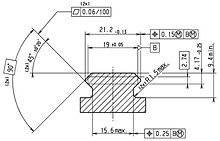NATO rail
The NATO rail is a standardized mounting rail according to STANAG 4694 for accessories for handguns . The standard was adopted on May 8, 2009 by the responsible NATO authorities.
Background and technology
The NATO rail is based on the Picatinny rail (MIL-STD-1913 / STANAG 2324) and is backwards compatible with it . This means that it can also accommodate accessories developed for the Picatinny rail. It was developed in cooperation with a number of weapon and accessory manufacturers, including Aimpoint , Beretta , Colt Canada , FN Herstal and Heckler & Koch .
In contrast to the Picatinny rail and its predecessor, the Weaver rail , the NATO rail is metric . Furthermore, dimensions and tolerances have been supplemented or adapted and, in particular, the straightness tolerance has been reduced by 50%. The reference surfaces for clamping the accessory parts have also been changed in order to ensure greater repeatability .
use
NATO rail is already on by the German Bundeswehr used rifle G28 use.
Further development
By using accessories that require electrical energy, such as tactical lights or residual light amplifiers , the weight of the weapon is greatly increased by the built-in batteries of the accessories and often creates a disruptive top-heaviness that makes it difficult to carry the weapon. The aim of the development is to modify the STANAG 4694 rail in such a way that, for example, a battery housed in the handle enables the distribution of power to the accessories. The advantage of this system would be a positive shift in the center of gravity, weight reduction, improved interoperability and the introduction of energy management .
Web links
Individual evidence
- ↑ a b NATO Infantry Weapons Standardization, NATO Weapons & Sensors Working Group, PDF, 650.76KB ( Memento from December 29, 2009 in the Internet Archive )
- ↑ Andrew White: NATO countries finalize plans for a standard rail adapter system. In: Jane's Defense Security Report, May 20, 2009.
- ^ Per G. Arvidsson: NATO Infantry Weapons Standardization. (PDF, 650.76KB) NATO Weapons & Sensors Working Group, May 27, 2009, p. 13 , accessed on July 6, 2014 (English).
- ^ Per G. Arvidsson: NATO Infantry Weapons Standardization. (PDF, 650.76KB) NATO Weapons & Sensors Working Group, May 27, 2009, p. 14 , accessed on July 6, 2014 .
- ↑ Product description G28. Heckler & Koch, accessed on July 6, 2014 (German).
- ↑ Torbjoern Eld: Powered Rail. (PDF) (No longer available online.) NATO Weapons & Sensors Working Group, May 20, 2009, p. 5 , archived from the original on September 24, 2015 ; accessed on November 11, 2014 .
- ↑ Torbjoern Eld: Powered Rail. (PDF) (No longer available online.) NATO Weapons & Sensors Working Group, May 20, 2009, p. 6 , archived from the original on September 24, 2015 ; accessed on November 11, 2014 .


